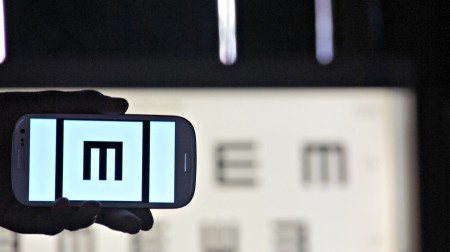
Peek Acuity vision check app being tested in Nakuru, Kenya.
Credit: Peek Vision
Updated on 25 May 2018
This product update applies to users of Peek Acuity and Peek Acuity Pro vision check apps.
We have discovered that some Android devices are misreporting pixel density, a measure of a device’s screen resolution. Peek Acuity and Peek Acuity Pro vision check apps use pixel density to determine the correct sizing for the letters used in the “tumbling E” vision chart on which the app is based.
On devices which misreport pixel density, this leads to incorrect sizing for the letters on which the vision check is based, which could lead to inaccurate results for the Peek Acuity and Peek Acuity Pro vision check apps.
As far as we’re aware, the problem of some Android devices misreporting pixel density hasn’t previously been identified. It affects not just the Peek Acuity apps, but other applications which use the same method to produce accurate sizing, such as “ruler” apps.
**Update**
We have now released an update which offers a manual calibration check for Peek Acuity and Peek Acuity Pro. It prompts users to check their device is reporting pixel density correctly, using a ruler or measuring tape to confirm the size of “E” generated by the test. There’s more information about this on the calibration page and FAQs.
It is important to keep the application up to date at all times so that you receive the latest technical updates.
If your device is affected please do not use Peek Acuity to conduct vision checks until we have released an update, as the results will be inaccurate. When used in a correctly functioning device, Peek Acuity is clinically validated and at least as accurate as conventional vision charts.
If you have any questions or concerns, please contact us.
Specific devices of the following two models have been observed to be affected:
Samsung J5 (2015)
Huawei MediaPad T3 7″ Tablet